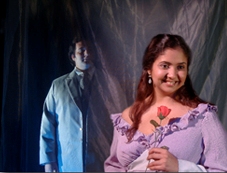
Femme Fatale at CCM
Although
he is very much alive, composer Daniel Catan enjoys playing the role of “dead
composer," he said.

Mexican born Catan, whose “Rappaccini’s Daughter” will receive its Cincinnati premiere May 30-June 1 at the University of Cincinnati College-Conservatory of Music, rehearsed the cast for the opera on a visit to CCM earlier this year.
“Last time I came I heard the students who would sing and they did a beautiful job. It is time for me to come and watch."
The opera, premiered in 1991 in
Catan is also the composer of "Florencia en el Amazonas," to be performed by Cincinnati Opera July 10 and 12 at Music Hall in its regional premiere.
Set in Renaissance Italy, "Rappaccini's Daughter" is the final production of CCM’s 2007-08 Studio Series and the first under the aegis of the new Corbett Foundation Opera Fusion Program.
Announced last fall, the program is a three-year joint venture by CCM and Cincinnati Opera including collaborative academic programming, enhanced young artist and internship opportunities for CCM students during Cincinnati Opera’s summer festival and an annual opera production at CCM.
Based on a short story by Nathaniel Hawthorne adapted by Nobel Prize-winning Mexican author Octavio Paz, "Rappaccini's Daughter" is about the ultimate femme fatale.
A lovely young girl, Beatriz, is poison --
literally. It's not her fault, having
been raised in her father Dr. Rappaccini’s garden. Rappaccini is a physician/scientist who seeks
to cure illness with poisonous plants.
A
young student, Giovanni, has a room above the garden, where he becomes besotted
with Beatriz, though he does notice that she is a bit strange. A rose he tosses her wilts at her touch and she calls one
of the trees in the garden her “brother.”

Though warned by a friend about Rappaccini -- "for him, patients are merely material for experimentation" -- Giovanni persists in visiting Beatriz, who falls for him and thinks he might be able to rescue her from her prison. Rappaccini is all for it, since he believes that uniting Beatriz (death) with Giovanni (life) will produce immortality. Fearing for Giovanni, Baglioni gives him an antidote that he says will cure Beatriz. After berating her for not being what he thought, Giovanni gives Beatriz the antidote. Saddened by his rebuke, she drinks it and promptly dies.
To be performed with piano accompaniment, the opera will be fully staged, with costumes, sets and lighting. It will be sung in Spanish with English supertitles. Karl Shymanovitz will conduct the all-student cast. Stage director is Karen Moe Miller.
"Rappaccini's Daughter" is Catan's second opera, but "publicly speaking,” his first, he said. "With my first one, I learned what not to do. The thing that I learned the most was how important the libretto is. It sounds silly, but most composers -- and I used to be one -- felt that most opera libretti are dumb. I thought it really doesn't matter what they're singing if the music is good -- and I was very wrong. Even though they seem dumb sometimes, they're not if they provide the right framework for the drama.
"It's like scaffolding. It has to be just right for the music to be in. The scaffolding then has to be withdrawn and the music delivered."
Hawthorne and Paz were a perfect
combination, said Catan. "The
strength of the Paz play is the poetry, the beauty of the lines, especially the
love part of it. It's very sensual.
What makes a good dramatist is not what
makes a good poet, said Catan, who now lives in
It’s the same with musicals, he said. "Somebody writes the book and somebody else writes the lyrics or songs. The guy who writes the songs is the poet. That's when time stops. The other has the machinery that keeps the play moving."
Catan, 59, started as a pianist, he said. "I was lined up to go to a conservatory and become a pianist. At a certain point, I kind of rebelled and said no, I don't want to be a musician. I don't want to be a pianist. Then I went and studied philosophy, which is perhaps even more useless. My parents thought they had saved me from a fate worse than death and then when I announced philosophy, they nearly collapsed."
It was while he was studying philosophy at
the
Catan moved from
Somewhat like Britten, who revived English
opera after a period of dormancy from the age of Purcell and Handel, Catan is
bringing opera in Spanish to the world stage.
Given its American premiere in 1994 by San Diego Opera,
"Rappaccini's Daughter" was the first opera by a Mexican composer to
be produced in the
Of opera in Spanish, "there's a total
lack," said Catan. "When the
Spanish Empire started collapsing, they became disconnected from the rest of
Europe to such an extent that
Interestingly, Catan has yet to have an
opera produced in
Catan's next opera, to be premiered by Los Angeles Opera under music director James Conlon in September, 2009, is "Il Postino," based on the popular Italian film. It will star tenors Placido Domingo and Rolando Villazon as Chilean poet Pablo Neruda and Mario the postman, respectively. "Imagine my writing for those two. I absolutely had a wonderful time inventing duets for them."
Though there is no cost of admission to “Rappaccini’s Daughter,” reservations are required. To reserve a seat, call (513) 556-4183. For information, visit www.ccm.uc.edu.